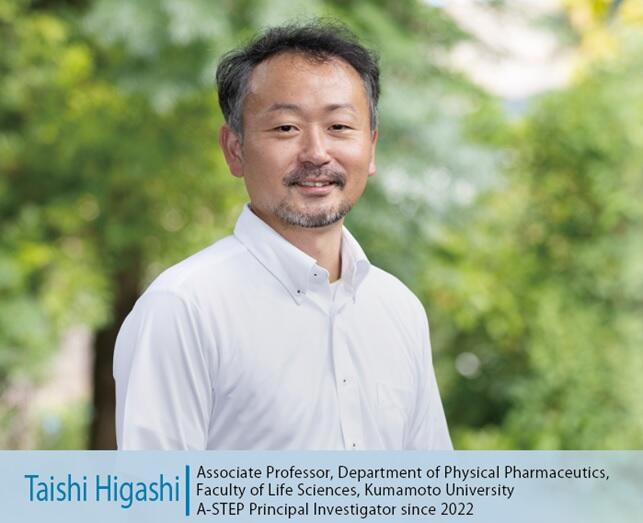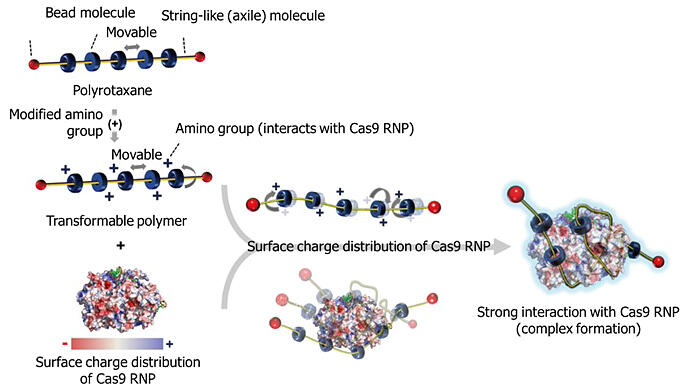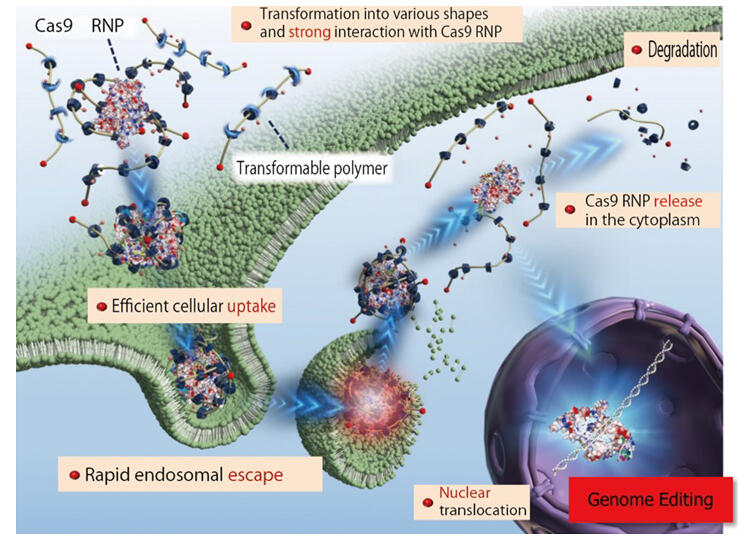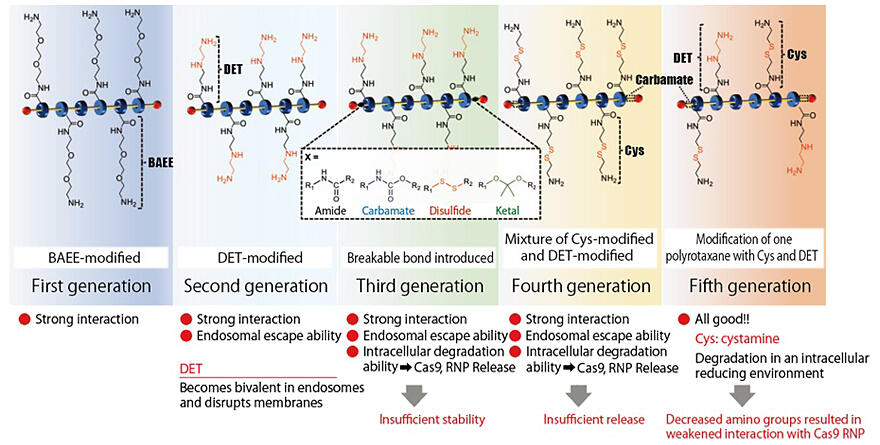In the segment 'A Look Around Innovation,' we introduce research and development (R&D) sites that have led to social implementation. In the 17th installment of this series, we introduce the efforts of Associate Professor Taishi Higashi of the Department of Physical Pharmaceutics, Faculty of Life Sciences, Kumamoto University, who is working on the development and implementation of "transformable polymers" that can efficiently introduce a wide variety of biological compounds into cells based on unique properties of supramolecules.

Polyrotaxane is the backbone: Literally, "molecules beyond molecules"
JST News visited the Oe Campus of Kumamoto University to meet a researcher who we heard is developing revolutionary supramolecule-based drug delivery systems for efficient intracellular delivery of nucleic acids, proteins, and other biological compounds. A large area of the campus, situated within a quiet residential area, is dedicated to the Medicinal Plant Park, home to a wide variety of medicinal plants. Associate Professor Taishi Higashi of the Laboratory of Physical Pharmaceutics of the Faculty of Life Sciences, which celebrated its 50th anniversary in 2024, is pursuing research on "transformable polymers," which he developed as carriers to deliver biological compounds into cells.
The developed polymers comprise supramolecules based on a "polyrotaxane" backbone. A supramolecule is a substance composed of multiple molecules assembled into a structure that behaves as if it were a single molecule. Supramolecules have attracted attention as "molecules beyond molecules," as the name suggests, because they exhibit many functions that their components alone cannot. Pharmaceutical researchers specializing in supramolecules are scarce, and this is where he has an advantage, Higashi said.
Polyrotaxanes are a type of compound consisting of a number of bead-shaped molecules called "cyclodextrins" threaded into a long, thin string-like molecule called polyethylene glycol, of which both ends are blocked. Cyclodextrins can move along the polyethylene glycol chain. When cyclodextrin units are modified with an appropriate functional group that interacts with the compound to be delivered, polyrotaxane can change their shapes according to the shape and charge distribution of the compound to be delivered, so that they can enclose the compound and deliver it into cells.
Placing a focus on genome-editing Cas9 ribonucleoprotein (RNP) — Many generations before overcoming all the barriers
While the transformable polymer platform is expected to be applicable for the delivery of various compounds, Higashi and his colleagues focused on Cas9 RNP, which is essential for genome editing (Figure 1). Cas9 RNP is a complex of "Cas9," a protein that acts as a scissor to cut DNA, and "guide RNA," a nucleic acid that tells the scissor what sequence should be cut.
Because Cas9 RNP is a hydrophilic polymer, it cannot enter cells independently and cannot be delivered efficiently into cells by conventional carriers. Even if it could be delivered into cells somehow, Cas9 RNP would be mostly degraded in "endosomes," which contain many enzymes that break down proteins and nucleic acids. Thus, there were several barriers to overcome before Cas9 RNPs could be delivered intracellularly.
Figure 1:Structure of polyrotaxane and the transformable polymer developed

Specifically, the carrier interacts with Cas9 RNP to form the complex, which is efficiently taken up by cells, escapes from endosomal degradation after cell entry, and releases Cas9 RNP from the carrier in the cytoplasm to allow for its translocation to the nucleus (Figure 2). To address these challenges, Higashi and his colleagues first modified the polyrotaxane backbone with a functional group called "bis(aminoethoxy)ethane" to construct a supramolecule. The resulting first-generation transformable polymer strongly interacted with Cas9 RNP and succeeded in intracellularly delivering Cas9 RNP more efficiently than conventional carriers; however, the challenge of endosomal escape remained unsolved.
Figure 2:Mechanisms by which transformable polymers overcome barriers

Then, they switched to a different functional group called "diethylenetriamine" to prepare the second-generation transformable polymer, which successfully exhibited the endosomal escape ability. After the third- and fourth-generation transformable polymers, in which the string-like molecule was further modified for efficient release of Cas9 RNP in the cytoplasm, the fifth-generation transformable polymer overcame all barriers for intracellular delivery of Cas9 RNP (Figure 3). Higashi said, "Our fifth-generation transformable polymer complexed with Cas9 RNP has superior introduction efficiency compared to the best commercially available carriers, and the currently available data raised no safety concerns."
Figure 3:Process of transformable polymer development

A-STEP project to achieve seventh generation: Newly establishing "supramolecular pharmaceutical sciences"
Higashi succeeded in developing a practical Cas9 RNP carrier while his research project was supported by the A-STEP tryout mechanism. He applied for the A-STEP fostering program with a research project to prove the usefulness of transformable polymers for other compounds and develop the sixth-generation Cas9 RNP carrier with further improved performance. His application was accepted for the program. To date, he has made further progress, including the development of an improved Cas9 RNP carrier that can be provided as a Cas9 RNP transfection reagent and the demonstration of the usefulness of the transformable polymer platform as intracellular transfection carriers for other compounds.
He said he would like to continue his research to realize the seventh-generation transformable polymer that can deliver drugs and other substances to specific organs in the human body. "It would be great if we could offer transformable polymers as inexpensive, easy-to-use, and efficient carriers that can be used during the development of new active pharmaceutical ingredients or in emergencies such as pandemics," says Higashi. He is also formulating strategies for systemic administration. Higashi recalls repeated failures in the course of his previous research. What helped him at those times was the presence of students in Higashi's laboratory, such as Mr. Toru Taharabaru. He said, "Even when things weren't going well, I trusted their high-level skills, so I was able to move on to the next step without pausing."
He added that the presence of "promotion advisors" assigned to each project to support social implementation was also important in the fostering program. "The promotion advisors advised me that even in practically oriented research, it is important to clarify the mechanism as science, and this advice gave me a hint when I evolved the seventh generation."
Higashi and his colleagues have also succeeded in synthesizing "polycatenanes," which have a necklace-like structure formed by joining the two ends of a string-like polyrotaxane. It is unknown today what polycatenanes find application, but they are expected to have potential as new research materials. Higashi has long been conducting research on supramolecules, starting with cyclodextrins, which represent a field that has not been studied so extensively in pharmaceutical sciences. To develop this field, he is establishing a new academic field named "supramolecular pharmaceutical sciences," a fusion of supramolecules and pharmaceutical sciences. He will launch the "Supramolecular Neo-Function Research Group" in 2025. Higashi's challenge to create the next-generation pharmaceutical sciences continues.
(Article: Sachiko Ito, Photography: Hideki Ishihara)




